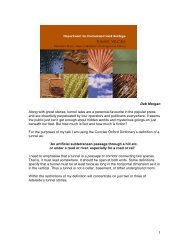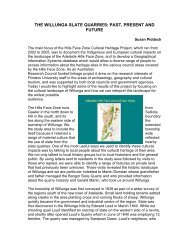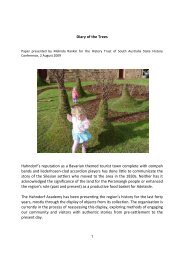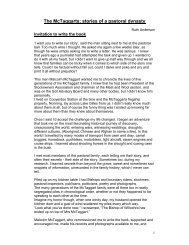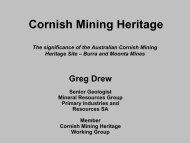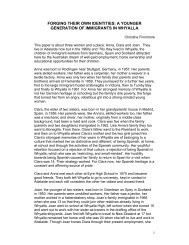Southward Bound Information - History SA
Southward Bound Information - History SA
Southward Bound Information - History SA
You also want an ePaper? Increase the reach of your titles
YUMPU automatically turns print PDFs into web optimized ePapers that Google loves.
Dinner shall commence at one o’clock and supper at six pm. The fire shall be<br />
extinguished by 7 p.m, migrants be in their berth by 10 p.m. Three safety lamps<br />
shall be lit at dusk and kept burning till 10 p.m after which hour two may be<br />
extinguished, but one must be kept burning at the main hatchway all night. No<br />
naked light shall be allowed at any time on any account.<br />
The scuttles and sternports, if any, shall weather permitting, be opened at 7 a.m<br />
and kept open till 10 p.m, and the hatches shall be kept open whenever the<br />
weather permits. The copper and cooking utensils shall be cleaned every day. The<br />
beds shall be well shaken and aired on deck at least twice a week. The bottom<br />
boards of the berths, if not fixtures, shall be removed and dry scrubbed and taken<br />
on deck at least twice a week. A space of deck room shall be apportioned for a<br />
hospital, not less, for vessels carrying 100 passengers, than 48 superficial feet,<br />
with two or four bed berths erected therein; not less for vessels carrying 200 or<br />
more passengers, than 120 superficial feet with six bed-berths.<br />
There were another ten paragraphs that dealt with washing days (two per week): a<br />
requirement that everyone should attend church service at 10 a.m. Sundays: no<br />
smoking between decks: no alcohol or gunpowder allowed to be taken aboard by<br />
migrants - if these items were discovered they were to be taken away and only<br />
returned at the end of the voyage: and a number of other routine matters. These<br />
regulations, in fact, set down in writing and gave official sanction to practices that<br />
most conscientious captains and owners had been observing the same years.<br />
Under these 1849 regulations the system often employed to regulate the cooking<br />
of rations in the earlier ships, now became mandatory, and the use of alcohol<br />
could be more strictly controlled. Many migrant ships had been dry long before<br />
1849. Some masters, of their own wish, did not permit any liquor aboard. Some<br />
ships, chartered by religious groups were only taken up on the express<br />
understanding that they would remain dry for the voyage. In the days of the<br />
colonisation commissioners they strongly recommended to captains that no<br />
spirituous liquor be taken aboard their ships.<br />
THE ROUTE:<br />
At Sea<br />
Although there was no prescribed route for ships journeying to South Australia in<br />
the 1840’s captains/navigators followed the Admiralty Route, which took about 120<br />
days. This route recommended a call at Cape of Good Hope and that the parallel<br />
(latitude) of 39 South was the best upon which to run their eastings down. On a<br />
flat map this looks to be the shortest distance. However, because the earth is a<br />
sphere, the shortest distance between 2 points on it must be a curve. Using this<br />
theory, a route was devised which involved going as far south as ice would allow,<br />
It was found that south of the 40th parallel the winds were also much more<br />
favourable (the roaring forties).<br />
In 1850 Captain Godfrey in the Constance ventured far south following this theory<br />
(called Great Circle Sailing). He reached Adelaide in a record of 77 days, but<br />
before the gold rush, no one dared follow. The gold rush of the 1850s made great



